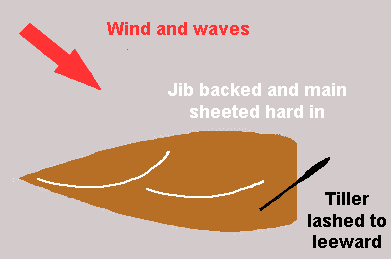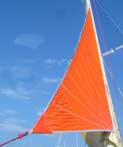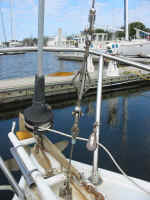Heavy weather conditions at sea
Heavy weather tactics
In very heavy weather conditions, there are a variety of approaches and philosophies that can be employed.
-
Run for shelter
If you can reach safety before a storm arrives, this must be the best approach. However, remember that it is the land and shallow water that presents the most danger in storms. If you can not reach harbour before the storm, you may have to make the tough decision to stay out at sea rather than approach the coast. With a scared and tired crew this is one of the toughest decisions a skipper will ever make.
It may be possible to hide behind a piece of land or shallower water that may reduce the sea state, just be careful of any likely wind shifts, it can be very easy to be trapped on a lee shore.
A colleague of mine had just crossed the Bay of Biscay where they experienced winds of over 50 knots for 30 hours, when they arrived at the Needles Channel off the Isle of Wight, the conditions were force 6 to 7 from the south west and against the outgoing tide. He sensibly decided to sail round the east of the island and enter in the shelter because he did not want to risk the Needles Channel in those conditions.
If the crew's mind set has become fixed on arriving by a certain time and there is a sudden change of plan like this it can be a difficult situation to handle, but adding a few hours to a trip is far preferable than it all going wrong in the last couple of miles.
-
Gain sea room
If a storm is coming, the boat should be heading to where you will have the most sea room. The sea room primarily needs to be in the downwind direction, allowing for any wind shifts!
-
Lie to a sea anchor
A sea anchor is a large parachute that is streamed over the bow. The idea is that it holds the bow up to the waves, which then break down either side of the boat. A sea anchor will prevent the boat losing too much ground to leeward.
They work best in heavy displacement, long-keeled, cruising yachts. They can place large stresses on the boat fittings and if the boat is forced backwards by a wave, the rudder can be sheared off a modern fin keel yacht. Once deployed, the anchor is probably irrecoverable until the storm has passed, otherwise it may be necessary to jettison it.
-
Heave to
Heaving to either under storm sails or in extreme conditions under bare poles can be effective in a buoyant, long keeled yacht. Again, this tactic minimises the ground lost to leeward. Unfortunately modern fin keel yachts tend to heave to beam on to the waves, this would be extremely dangerous in a storm, as the yacht would be rolled over by a large breaking wave.

To heave to, you need the minimum amount of sail possible, normally a very deep reefed main or trysail, the boat is then headed as close to the wind as possible and the wheel lashed to keep the head up in to the seas.
In extreme wind strengths you may need to heave to under bare poles, in this case the drive provided by the mast is sufficient to give steerage.
A combination method that has worked is to run the engine sufficiently to keep the boat's head up in to the sea. This is only an option if the cooling water inlet stays below the water and the engine can pump oil at large angles of heel.
Remember that severe seas will disturb the fuel in the tank and any rubbish in the bottom of the tank will be mixed up with the fuel supply causing the engine to fail. If you know there is heavy weather coming, try to fill the tanks from any spare fuel containers you are carrying. The only practical way to do this at sea is to pump the fuel or use a siphon to transfer the fuel from any containers to the main tank (wine making siphons are ideal).
-
Run off before the storm
Running downwind (with sails or bare poles) can be a good tactic in a modern, fast yacht: if there are sufficiently skilled helmsmen to do so for hours, and have plenty of sea room! The danger of running, is that if you travel faster than the waves, it is possible to dig the bow in to the back of the wave ahead, the boat then stops, is picked up by the next wave and rolled end over end (pitch poling). It is also very easy to broach on a breaking wave and end up beam on to the sea.
You also will use up a lot of ground to leeward, beware of any land or shallows downwind of your position.
-
Trailing warps or drogues
To slow the boat down long ropes can be let out the back; they need to be in a loop and to reach two wavelengths back if possible. The idea is to stop the boat surfing faster than the waves. A similar approach is to use purpose built small drogues, similar to small sea anchors.

The danger of slowing the boat too much is that you may be pooped. This occurs when a wave breaks on the stern of the boat, filling the cockpit and possibly smashing in the main hatch.
-
Release oil
An old technique is to pour oil on the sea to reduce the breaking waves. Apart from the environmental considerations, few yachts would carry sufficient to have any effect. Although some people have reported success with pumping cooking oil out through the heads whilst lying ahull (hove to under bare poles).
The boat slowly slips to leeward leaving an oil slick and the extra surface tension of the oil on the surface reduces the tendency of the waves to windward to break and thus protects the boat.
-
Boat preparation
People often talk about preparing a boat for heavy weather. You need to assume that it is always possible that you will experience heavy weather on any trip, so the preparation begins every time before you leave harbour.
Make sure you have the right safety equipment, the crew are suitably clothed, the boat is well maintained, the hatches are closed and there is nothing that will fly round the boat or be washed off the deck.
In the UK, small commercial vessels (school and charter yachts) must have devices to retain the cooker and the batteries in the case of being inverted. They also need to have hatches that can not fall out if the boat is rolled but that can be opened from either side.
The only extra preparation I normally do is to rig ropes through the cabin if there are insufficient hand rails (wide cabins can be tricky to negotiate in a storm). It can also be a good idea for the crew on deck to have two harness lines attached so that they can brace themselves against them. It is easy to sustain minor injury by being thrown against cockpit fitting by breaking waves or to damage some of the fittings!
-
Storm sails
All yachts should have sails that are suitable for heavy weather. This means at least 3 reef points in the mainsail, preferably ones that can be rigged without removing an earlier reef to do so. Some boats with a very high proportion of the sail area concentrated in the main may require a fourth reef for really serious conditions.
Ocean cruising boats should consider carrying a trysail, this can be  invaluable when it is seriously rough weather. The benefits are:
invaluable when it is seriously rough weather. The benefits are:
- The boom can be lashed out of the way
- The sail plan in lower in the boat
- The material is very heavy duty
They do need practice so that you can rig it in the real conditions at sea without having to read the instructions.
The biggest practical problem is what to do with the head sails. If you have a hanking on or head foil system you just need to carry a suitable sized storm jib. If you have a roller furling system it is a lot more of a challenge.
Few furling genoas work well in winds of more than force 6, normally they start to "bag" in the middle as you roll more of the sail in. Having a foamed luff helps but there is still a limit.
There must be a system for rigging a storm jib. From experience, the only  system I would rely on is where there is a second removable forestay that can be brought forwards when needed and a storm jib hanked on. None of the other systems I have tried really convinced me that they could be relied on in the real conditions at sea.
system I would rely on is where there is a second removable forestay that can be brought forwards when needed and a storm jib hanked on. None of the other systems I have tried really convinced me that they could be relied on in the real conditions at sea.
Visit the excellent website atomvoyages.com for more pictures of how it works.
As with all equipment, practice with it in harbour, then go out in some controlled heavy weather conditions and try it out again before you are having to do it for real. Frequently you will find minor glitches that mean you will need to adjust the way you rig the equipment up.
I was testing the heavy weather equipment on a large Oyster one day, so we decided to sail out in to the English Channel in about 40 knots of wind. In sheltered water I had no difficulty rigging the inner forestay, but in the real conditions, as soon as I released it from the deck the weight of 70 feet of stainless steel being whipped about was enough to lift me clean off the deck.
It had never occurred to me just how heavy the wire would be in those sort of seas, I realised after that the best approach would have been to head down wind whilst we rigged the forestay.
-
Conclusion
As you can see, there are no definite answers. A prudent skipper will read as much as possible about the tactics employed by other people and consider their relevance to their own boat.
One of the major challenges is exhaustion, in a storm most people can not stay on deck for more that 20-30 minutes at a time, especially in colder climates. Part of the problem is the impact of water travelling at 70 knots striking any bare skin or your eyes, a pair of clear ski goggles and neoprene ski mask can help increase the time you are able to work on deck.
Not many people are sufficiently skilled to handle steering a yacht in extreme weather, particularly when it comes to negotiating large breaking waves, great care is needed when changing the helm as it may take a few minutes for the new helm to get used to the conditions.
You also need to ensure that there is suitable food available, it may be possible to prepare something and have it stored ready for use but in practice you not often manage more than fruit and biscuits.
The best source of ideas it to read articles by those people who have survived real storms at sea and to learn from their tactics. Whatever you try, you should be ready for changing conditions which will call for a change of tactics.
Magazine articles are very informative and the following books, will give you lots of examples and ideas:
Sailtrain.co.uk is free to use, but if you feel you would like to contribute to the running and development costs you can donate via Paypal:
Additional Resources:

